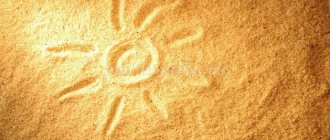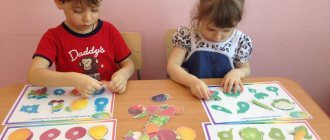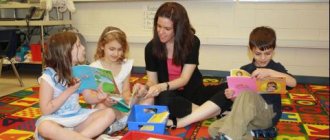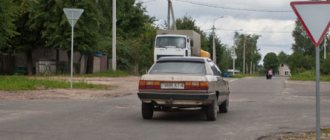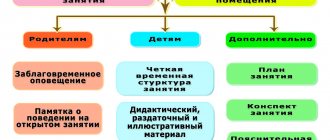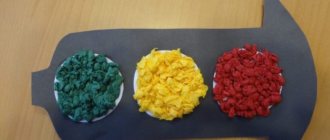Summary of educational activities with preschoolers in the senior group on the topic “Hats”, cognitive development
Transcript
1 Summary of educational activities with preschoolers in the senior group on the topic “Hats”, cognitive development 1. Integration of educational areas Educational areas Cognitive development Speech development Social communicative Objectives To clarify and expand children’s knowledge about the variety of hats. Distinguish and name hats worn by people of different professions. Enrich children's knowledge about the properties of the materials from which hats are made. Develop the ability to classify and characterize the materials from which they are made. To support children's interest in storytelling on their own initiative, to teach them to convey the verbal content of a picture in the form of a short story. Formation of friendly relationships and cooperation skills. Cultivating a caring attitude towards hats. 2. Types of children's activities: play, cognitive research, communication. 3. Materials and equipment: fragment of the cartoon “He’s so absent-minded”, slide 1. hats, slide 2. hats made of different materials, slide 3. pictures depicting people of different professions, slide 4. game “pick up a hat”, slide 5. headdresses for women, men and children, slides 6-9 fairy-tale characters. 4. Logic of GCD Forms of work Greeting ritual Let’s hold hands together And smile at each other. We will shake hands, the warmth will run in a circle. Together we will answer questions very friendly. We all want to study, we all want to know a lot. Motivational orientation stage. Guys, watch a fragment of the cartoon. (“He’s so absent-minded”). Who is this cartoon about? (about an absent-minded person). And who Expected result An emotional mood and motivational readiness to participate in the work have been created.
2 wrote this poem? (S. Ya. Marshak). Guys, what did he wear instead of a hat? What do people wear on their heads? (hats, hats, caps, Panama hats, baseball caps, berets, scarves, caps, how can we call it all in two words? How can we call it in one word? I propose to take a journey into the kingdom of headdresses. Slide 1. Hats Actively and friendly interact with teacher and peers in solving cognitive problems. What hats do you see? Describe them? Why do you think we wear some hats in winter and others in summer? They are made of different materials. The ability to answer questions has been reinforced. Slide 2. Hats from different materials Name what these hats are made of and what they are made of. Do you think all people wear the same hats. Guys, what other hats are there? If they are worn by a man, then If they are worn by a woman, then If a child wears them, then Slide 3. Women's, men's and children's hats. Lexical and grammatical skills and abilities (formation of adjectives from nouns) are consolidated.
3 The ability to answer questions has been strengthened. The ability to classify hats into men's, children's and women's has been consolidated. Dynamic pause We have become chickens in yellow hats. The child flaps his arms like a chicken's wings. In white hats we became bunnies, showing bunny ears. In red caps we became mushrooms, joining hands above our heads. In black caps, blueberries sit on the hummocks and squat down. In blue rain caps, he gets up and puts his hands on his belt. And they easily galloped along the paths. Jumping forward on two legs. Children follow the teacher and experience the joy of physical exercise. Slide 5. Pictures depicting people of different professions They know and name the hats worn by people of different professions. What professions are people depicted in the paintings? Slide 6. Game “Pick up a hat” They actively and friendly interact with the teacher and peers in solving cognitive problems.
4 What kind of hats do they use, and what do they need them for? Guys, not only people wear hats, but also fairy-tale heroes. To find out what heroes are, you need to solve riddles. The grandmother loved the girl very much and gave her Little Red Riding Hood. The girl forgot her name. Well, tell me her name? (Little Red Riding Hood) Slide 6. Little Red Riding Hood They experience positive emotions from correctly solved cognitive tasks. The ability to solve riddles has been strengthened. My father had a strange boy, an unusual wooden one. But the father loved his son. What kind of strange little wooden man is this? On land and under water Looking for a golden key? (Pinocchio) Slide 7. Pinocchio Treats small children, Treats birds and animals. The Good Doctor (Aibolit) looks at them through glasses Slide 8. Aibolit
5 My outfit is colorful, my cap is sharp. My jokes and laughter amuse everyone! (Parsley) Slide 9. Parsley Reflection
Games and exercises
Ball game “One - many” Panama hat – many Panama hats hat – hat – beret – scarf – cap – scarf – “Name what these objects are” felt hat – felt hat wool hat – silk scarf – fleece beret – leather cap - “What is missing” (game with pictures, remember all the hats, then close one picture) - the game develops visual attention and memory.
Exercise to develop sound analysis skills (for children 5-7 years old)
“What is the first sound in a word? (last)". Takes - beat (t) handkerchief - p (k), etc. “Count to 5” (for children from 4 years old) One hat, two hats, three..., four..., five hats. (for children over 6 years old) One leather cap, ………… five leather caps. Straw hat Woolen scarf Play the ball game “Which one?” Which? Which? Which?" You throw a ball to your child and name the objects, the child catches the ball, says what they are, and returns the ball to you. Straw hat (what kind?) – straw. A hat made of felt (which one?) - felt. A scarf made of down (which one?) - downy. Wool hat (what kind?) – wool. Calico scarf (what kind?) - calico. Silk headscarf (what kind?) – silk. Panama hat made of cotton (which one?) – cotton Helmet made of plastic (which one?) – plastic Game “The Fourth Wheel”. Name what is superfluous, explain why? Hat , coat, raincoat, skirt. Cap, Panama, boots , scarf. Boots, hat , sandals, slippers. Sandals, headscarf , sneakers, felt boots. Game “Walk a Word” Invite your child to remember the names of hats and take as many steps as there are syllables in the word (hat-ka, cap-ka, hat-pa, shawl-tok, fu-razh-ka, pi-lot-ka, ko -son, etc.).
